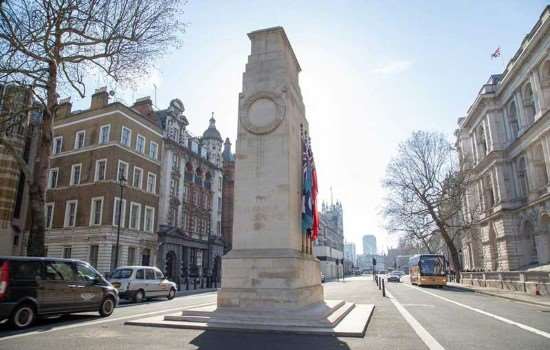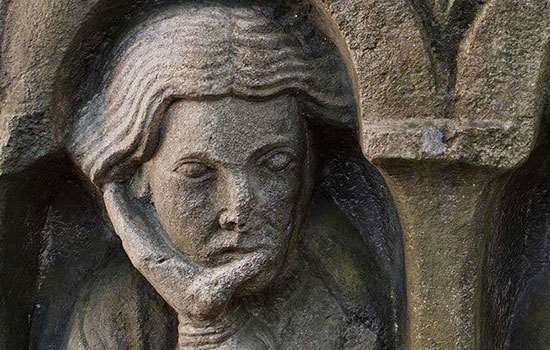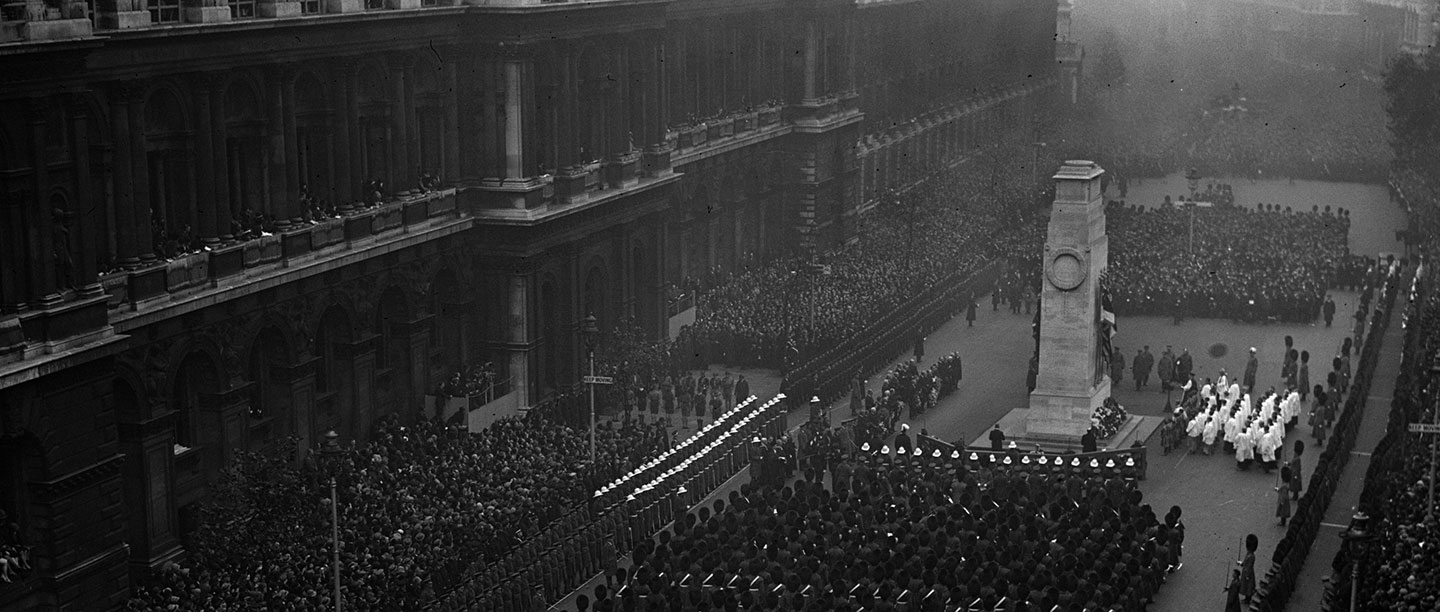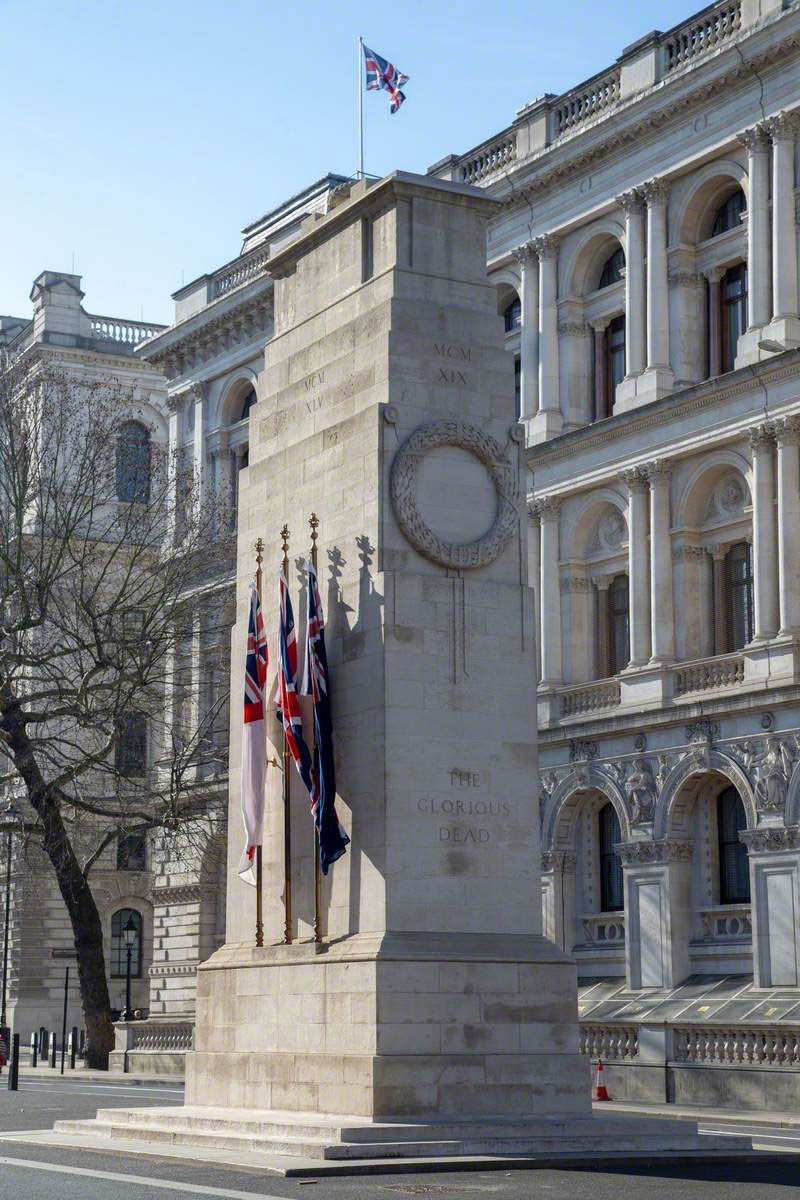Burial and Commemoration
By the end of the First World War over 1,100,000 men from Great Britain and the British Empire had died in the conflict – every community and family sharing to some degree in the grief for those lost lives.
At an early stage in the war a decision had been taken not to repatriate any of the bodies of the fallen, but to bury them in war cemeteries near to where they fell. Furthermore, in the shocking intensity of the warfare on the Western Front, almost half of the fallen had simply disappeared. Many of the dead who were found could not be identified, and had to be interred anonymously.
None of the grieving families had graves to visit at home. Instead, across Britain and its Empire many thousands of war memorials were built in the post-war years, including private memorials to individuals, memorial crosses in parish churchyards, and municipal monuments in almost every town and city. Individual regiments and other military groups and formations built monuments to their dead, several of which are in central London. However, the Cenotaph in Whitehall has always had a pre-eminent place as the nation’s main place of commemoration of its war dead.
War Memorials in England
Before the 20th century, war memorials in England, as in the United Kingdom generally, had mostly been conceived as memorials to victory. Wealth and social rank usually determined which individuals were commemorated – many churches and cathedrals have monuments to commanders and officers who had fallen in combat. There were almost no monuments to the common soldiers and sailors who had died and were buried in unmarked graves overseas, or at sea.
A few memorials were erected to the dead of the Crimean War (1853–6) and the Second Boer War (1899–1902) showing that attitudes were beginning to change. After the Great War the scale of the loss and bereavement demanded a more fitting response in each community and at a national level.
Read more about London WWI memorialsThe First Cenotaph
Although hostilities ceased with the Armistice of 11 November 1918, peace was not formally established in Europe until the signing of the Treaty of Versailles on 28 June 1919. In the lead up, the British government began to plan a day to celebrate victory and the peace which was due to be signed. They learnt that the French government was planning a victory parade through Paris to be held on 14 July, the plans for which included a ‘catafalque’ as a memorial to the dead, which the passing troops would salute. Impressed by this idea, Prime Minister David Lloyd George asked Sir Edwin Lutyens, the most celebrated British architect of the day, to design something similar. It was envisaged as a temporary structure erected for the occasion.[1]
Lutyens was apparently already thinking of designs for a war memorial in an abstract form – a sketch by him of a design similar to the eventual Cenotaph is dated 4 June 1919. He developed his design very quickly: it was approved on 7 July, leaving only 11 days for it to be built by the Office of Works’ contractors. The wood, plaster and canvas memorial was unveiled on 18 July on the present site outside the Foreign Office building in Whitehall. It formed one of a number of foci for the Victory Parade the following day.
The Cenotaph made a deep impression on the public and within a couple of days over a million people had visited it, a great many of them laying wreaths there. Lutyens’s subtle design responded perfectly to the national sense of grief and loss. Two days after the parade, The Times observed that:
The Cenotaph is only a temporary structure made to look like stone, but Sir Edwin Lutyens’ design is so grave, severe and beautiful that one might well wish it were indeed of stone and permanent.[2]
Sir Edwin Lutyens
Edwin Lutyens (1869–1944), the son of a soldier turned artist, was articled to the country-house architect Sir Ernest George. He established his own practice in 1888, becoming a celebrated designer of Arts and Crafts houses in the south of England. After 1900 Lutyens’s work developed to include Classical buildings inspired by late 17th-century English architecture, in particular the work of Sir Christopher Wren.
Lutyens became one of the last great architects of the Classical tradition. Among his greatest achievements were some of the main government buildings in New Delhi, India.[3] He was also appointed as one of the architects to the Imperial (now Commonwealth) War Graves Commission.
In August 1917 Lutyens designed an altar-like Stone of Remembrance for British war cemeteries and eventually over 530 of them were created. In its massive simplicity and clarity of design, it is one of the starting-points for the design of the Cenotaph. He went on to design several other memorials for war cemeteries, most notably the Memorial to the Missing of the Somme at Thiepval, France, unveiled in 1924.[4]
Image: Sir Edwin Lutyens photographed around 1920
© National Portrait Gallery, London
The permanent monument
The public’s wish for the first Cenotaph to be replaced with a permanent version was unforeseen, but it was widespread and very strong. An alternative location on Horse Guards was considered, but Lutyens favoured the existing Whitehall site and on 30 July 1919 the Cabinet approved the idea of a permanent monument there.
The design of the permanent version was very similar to that of the first, but when Lutyens sent his designs to Sir Alfred Mond on 1 November 1919, he wrote:
I have made slight alterations to meet the conditions demanded by the setting out of its lines on subtle curvatures, the difference is almost imperceptible, yet sufficient to give it a sculpturesque quality and a life, that cannot pertain to rectangular blocks of stone.[5]
The effect of this change, though slight, can clearly be seen by comparing the photograph of the temporary Cenotaph at the 1919 Victory Parade (above) with images of the permanent version (below).
The permanent monument was built in Portland stone by the contractors Holland, Hannen & Cubitt for the Office of Works. It was unveiled by King George V at 11am on 11 November 1920, the second anniversary of the Armistice. In the same ceremony, the remains of an anonymous British soldier, exhumed from a war cemetery in France, were interred in Westminster Abbey to form the Tomb of the Unknown Soldier. Within a week, the Cenotaph had been visited by over one and a quarter million people, and was 10 feet deep in flowers.
Thereafter, each year on Armistice Day, the main national ceremony of remembrance was held at the Cenotaph. During the Second World War, the main service was moved to the nearest Sunday to 11 November to avoid disruption to industry, and in 1946 the Sunday was formally adopted as Remembrance Day – embracing both world wars and subsequent conflicts. The Cenotaph has remained the setting for the national ceremony ever since.
Design of the Cenotaph
Lutyens’s original 1919 design was for a tall pylon supporting a sarcophagus or coffin, adorned with laurel wreaths and the flags of the armed services. The permanent Cenotaph is very similar to the first, but is made of white Portland stone with subtle adjustments. His design methods were based on those of the ancient Greek architects of the Parthenon. Using these Classical proportions, all the surfaces subtly curve so that the verticals would meet at a point 1,000 feet above the ground, and the horizontals 900 feet to the side.
The design of the monument guides the eye upwards in a spiral motion: from the plinth, to the words ‘The Glorious Dead’, the flags on the sides, the dates of the war and the laurel wreaths – carved by the sculptor Francis Derwent Wood – and finally up to the sarcophagus on top. The sarcophagus is emphasised by its top-moulding which casts a shadow, and a third wreath is visible on top.
During the design process Lutyens made several sketches with variations including a figure of a fallen soldier, figures of lions and a flaming urn on top, but these were all dropped from the design.[6] Indeed, the genius of the Cenotaph as a memorial lies in its abstraction as much as its visual perfection. With no human figure and no national or religious imagery, it can have meaning for people of all races and of all faiths – or none.
Lutyens wanted to have sculpted flags on the sides, rather than real ones, but in this one respect the government disagreed.[7] As a result the Cenotaph is dressed with the flags of Britain’s armed services which are periodically renewed. Lutyens’s vision was of a monument that would be universal in its significance. The flags make it a national memorial, with specific military connotations. The Cenotaph can be read in both these ways – and in others.
The Cenotaph’s influence
Alongside the Cenotaph, war memorials were built throughout Great Britain. Some, such as the ‘Cross of Sacrifice’ designed by the architect Sir Reginald Blomfield, were specifically Christian in character and appropriate for churchyards and church cemeteries. Memorials for larger towns and cities were usually Classical and without specific religious imagery, probably for similar reasons to the Cenotaph, in that they had to have universal significance.
After the 1919 Cenotaph was unveiled, several towns and cities also engaged Lutyens to design their war memorials. He designed one of the first large town memorials at Southampton, unveiled on 6 November 1920, which is similar in form to the Cenotaph, though with more sculpted ornament. Manchester’s cenotaph is a close variant of the Whitehall design, with two flanking obelisks and the recumbent figure of a soldier on top. Rochdale’s cenotaph and the Midland Railway war memorial in Derby are somewhat more elaborated versions, again with recumbent figures.
The Cenotaph design was copied almost exactly in a number of other memorials: in the United Kingdom, there is the Queen’s Own Royal West Kent Regiment monument at Maidstone. Overseas, the design was reproduced exactly for cenotaphs in Hong Kong (1923), Auckland, New Zealand (1929), London, Ontario (1923) and Hamilton, Bermuda (1935).
Header Image: Armistice Day ceremony, November 1929.
© Fox Photos/Hulton Archive/Getty
Explore more
-

Visit the Cenotaph
Visit the Cenotaph monument in Whitehall, the focus of our Britain’s remembrance for a century.
-

Six London WWI Memorials
Explore six of London’s finest First World War memorials and their fascinating stories which reveal different approaches to commemorating the dead.
-

More Histories
Delve into our history pages to discover more about our sites, how they have changed over time, and who made them what they are today.

